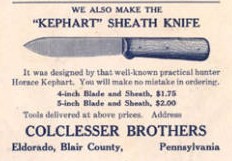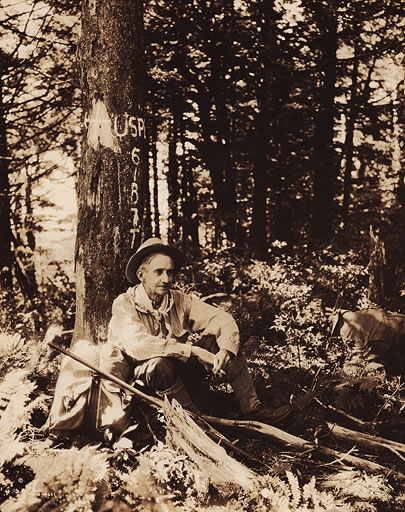In Search of the Perfect Knife By Glenn Ward Horace Kephart's books and articles in outdoor magazines established him as one of America's most trusted sources of information on spending time in the wilderness. Published in the first 30 years of the 20th Century, Kephart's writings were the result of his own experiences in the wild, as well as what he gathered from other writings and fellow woodsmen. His opinions are still respected as gospel among many who seek life in the wilderness, and none of his wisdom has been more tried and proven than his ideals on sheath knives, eventually leading to a pattern that still bears his name to this day. Building upon and paying hommage to the writings of George 'Nessmuk" Sears, Kephart published The Book of Camping and Woodcraft; A Guide for Those Who Travel in the Wilderness, first in 1906 and then in revised form in 1921. In this book, complied from a series of articles he wrote for Field and Stream Magazine, Kephart was very specific about tried and true methods and tools for a liesurely life of hiking, camping, hunting and fishing. Like Nessmuk he subscribed to the idea that a woodsman should always have three tools at his disposal: an axe, an all-purpose knife, and a pocket knife for smaller tasks. He prefered the double-bitted axe of Nessmuk and an easy-open jack knife, both readily available from mail order houses and local hardware merchants. But finding the right knife to serve all his camp needs was a more difficult task. Trial and error led to him condense his experiences to a knife prototype that he had to have locally made to suit his needs. "On the subject of hunting knives I am tempted to be diffuse. In my green and callow days (perhaps not yet over) I tried nearly everything in the knife line from a shoemaker's skiver to a machete, and I had knives made to order. The conventional hunting knife is, or was until quite recently, of the familiar dime-novel pattern invented by Colonel Bowie. Such a knife is too thick and clumsy to whittle with, much too thick for a good skinning knife, and too sharply pointed to cook and eat with. It is always tempered too hard. When put to the rough service for which it is supposed to be intended, as in cutting through the ossified false ribs of an old buck, it is an even bet that out will come a nick as big as a saw-tooth — and Sheridan forty miles from a grindstone! Such a knife is shaped expressly for stabbing, which is about the very last thing that a woodsman ever has occasion to do, our lamented grandmothers to the contrary notwithstanding." A camper has use for a common-sense sheath-knife, sometimes for dressing big game, but oftener for such homely work as cutting sticks, slicing bacon, and frying "spuds." For such purposes a rather thin, broadpointed blade is required, and it need not be over four or five inches long. Nothing is gained by a longer blade, and it would be in one's way every time he sat down. Such a knife, bearing the marks of hard usage, lies before me. Its blade and handle are each 4 1/2 inches long, the blade being 1 inch wide, 1/8th inch thick on the back, broad pointed, and continued through the handle as a hasp and riveted to it. It is tempered hard enough to cut green hardwood sticks, but soft enough so that when it strikes a knot or bone it will, if anything, turn rather than nick; then a whetstone soon puts it in order. The Abyssinians have a saying, "If a sword bends, we can straighten it; but if it breaks, who can mend it? " So with a knife or hatchet. The handle of this knife is of oval cross-section, long enough to give a good grip for the whole hand, and with no sharp edges to blister one's hand. It has a 1/4 inch knob behind the cutting edge as a guard, but there is no guard on the back, for it would be useless and in the way. The handle is of light but hard wood, 3/4 inch thick at the butt and tapering to 1/2 inch forward, so as to enter the sheath easily and grip it tightly. If it were heavy it would make the knife drop out when I stooped over. The sheath has a slit frog binding tightly on the belt, and keeping the knife well up on my side. This knife weighs only 4 ounces. It was made by a country blacksmith, and is one of the homeliest things I ever saw; but it has outlived in my affections the score of other knives that I have used in competition with it, and has done more work than all of them put together." Kephart's search for the perfect knife was much like and inspired my own search. In my "green and callow days" most certainly not over I have looked high and low for a knife that fits the criteria that Kephart described. From the time I first saw and read copies of The Book of Camping and Woodcraft and Kephart's seminal work, Our Southern Highlanders, at about age 15, I have been looking for that one sheath knife that could sustain me in the wilderness if I learn how to use it. Kephart's design was eventually adopted by the Colclesser Bros. Cutlery Company and bore his name, but was out of production decades before I was born. So I had to find a substitute. Or substitutes, as it were. Living very near the Smoky Mountain Knife Works in Sevierville, TN, I have tried Case, Buck, Frost, Remington, Winchester, many German blades, many off brands and vintage hunting knives and knives from the Middle East and the Orient over the years. None of them have ever fit the bill for me. All have worked well. None seemed suited for all tasks. Many were great for skinning game. Others were good work knives and could double up come dinnertime. Many lacked the full tangs required for woodcraft. Hardly any could I imagine separating firewood. Almost all were tempered too hard for easy sharpening in the wilderness. None could do all the jobs Kephart said his could do. Recently I reread The Book of Camping and Woodcraft and started researching the perfect knife again. I was delighted to find that many handcrafters were making their own version of the Kephart these days and at least one company, Bark River Knives, is producing a fine knife with Kephart's dimensions and the basic pattern. But both these options cost between $130 and $200, way too steep for my blood considering I already have a hundred knives. There is, however, a couple of other things about these knives that bother me in the fact that they deviate from the Kephart concept as I understand it. Some of these knives are tempered much harder on the Rockwell Scale that what Kephart was describing. Kephart meant for his blade to be soft enough to be easily touched up with a pocket-sized whetstone or on a smooth river rock in an absolute pinch. I've never even held a Bark River Kephart in my hand and can tell you it is a superb instrument, but all the descriptions I have seen have descibed it as being made of "tool steel." I'm sure that is better suited for today's outdoorsman, a razor sharp edge that was good for many hours of rigorous cutting before dullng down. Today's busy camper is already in the truck heading back to civilization before that ever happens. They can sharpen that tool steel knife in the privacy of their own shop or have it sharpened by a professional. Imagine sharpening a socket wrench on a river rock. I can't imagine rubbing a $150 mirror-polished Bark River on a river rock for any reason. The handmade Kepharts are often made of softer high carbon steel and would be much easier to sharpen in the wilderness without heavy sharpening equipment. Some of them are even more reasonably priced at around $80. Some are works of art. The problem I have with them is that almost all without fail are made with a blade of 1 1/4 inches to 1 1/2 inches wide. Kephart was very specific about the dimensions he found to work best. In Camping and Woodcraft and the Colclesser Bros. knife and in the authentic Bark River Kepharts, the blades are one inch wide. This difference may be frivilous for all practical purposes. It's my guess that Kephart would have marveled at the high quality cutlery produced in his name. Afterall, a tool is only as good as the man using it. I'm sure he could make do with any of them. But I also reckon he would return to his original design that worked best for him. Having disqualified everything else for various reasons, I needed to come up with a Kephart knife on a budget. I figured if my experiments didn't work out maybe I could sell all my hundred knives and buy one Bark River Kephart. Whatever the outcome I wanted one that's authentic. No one has ever been able to second guess Kephart on the perfect woodcraft knife and I'm sure I wouldn't be able either, I decided to make my own Kephart or have it commissioned to be made, but I wasn't prepared to compromise on any of the major specifications. References: Kephart, Horace (1988). Camping and Woodcraft: A Handbook for Vacation Campers and for Travelers in the Wilderness. Univ of Tennessee Pr. ISBN 0-87049-551-8. |
  (Top)An advertisement for a knife manufactured to the design and physical dimensions described by Kephart in The Book of Camping and Woodcraft; A Guide for Those Who Travel in the Wilderness. (Bottom) A production model of the Colclessor Bros. Kephart knife. Both items were personal possessions of Kephart and are now in The Hunter Library Special Collections at the University of Western Carolina. Photo credits: The Hunter Library Digital Collections.  Here I am at Kephart's grave in Bryson City, NC, February 2008. Marker reads: "Scholar, Author, Outdoorsman. He loved his neighbors and pictured them in 'Our Southern Highlanders'. His vision helped to create The Great Smoky Mountains National Park." Kephart Knife Specifications
 |